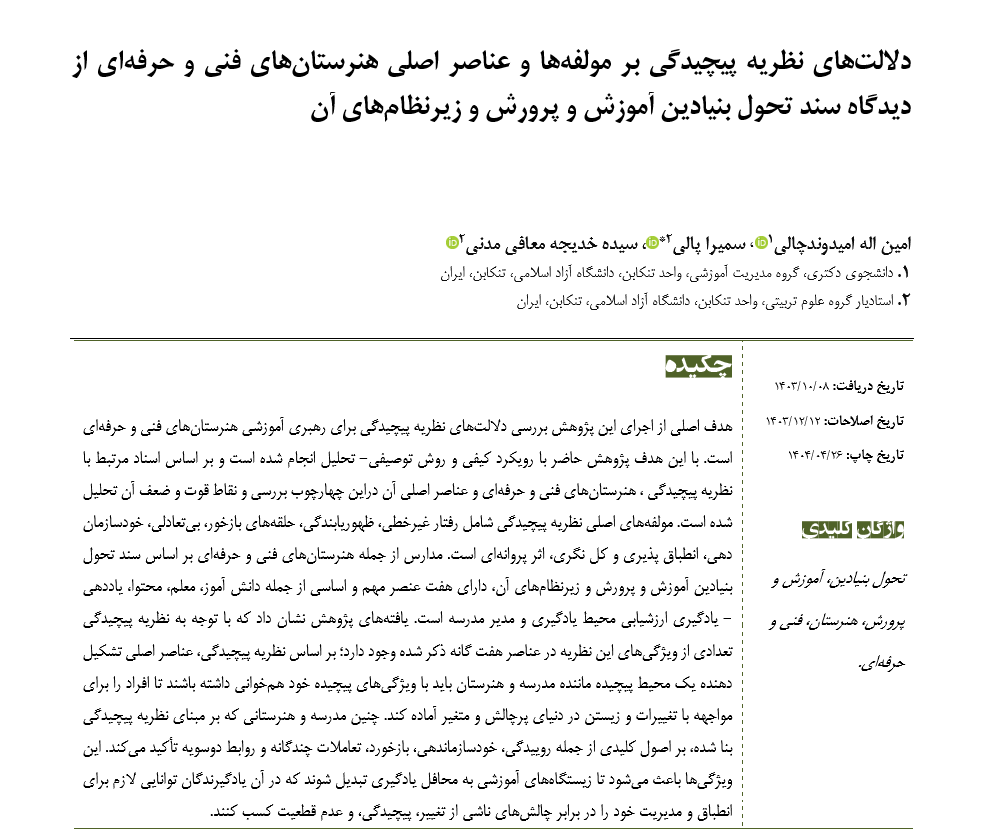دلالتهای نظریه پیچیدگی بر مولفهها و عناصر اصلی هنرستانهای فنی و حرفهای از دیدگاه سند تحول بنیادین آموزش و پرورش و زیرنظامهای آن
کلمات کلیدی:
تحول بنیادین, آموزش و پرورش, هنرستان, فنی و حرفه¬ایچکیده
هدف اصلی از اجرای این پژوهش بررسی دلالتهای نظریه پیچیدگی برای رهبری آموزشی هنرستانهای فنی و حرفهای است. با این هدف پژوهش حاضر با رویکرد کیفی و روش توصیفی- تحلیل انجام شده است و بر اساس اسناد مرتبط با نظریه پیچیدگی ، هنرستانهای فنی و حرفهای و عناصر اصلی آن دراین چهارچوب بررسی و نقاط قوت و ضعف آن تحلیل شده است. مولفههای اصلی نظریه پیچیدگی شامل رفتار غیرخطی، ظهوریابندگی، حلقههای بازخور، بیتعادلی، خودسازمان دهی، انطباق پذیری و كل نگری، اثر پروانهای است. مدارس از جمله هنرستانهای فنی و حرفهای بر اساس سند تحول بنیادین آموزش و پرورش و زیرنظامهای آن، دارای هفت عنصر مهم و اساسی از جمله دانش آموز، معلم، محتوا، یاددهی - یادگیری ارزشیابی محیط یادگیری و مدیر مدرسه است. یافتههای پژوهش نشان داد که با توجه به نظریه پیچیدگی تعدادی از ویژگیهای این نظریه در عناصر هفت گانه ذکر شده وجود دارد؛ بر اساس نظریه پیچیدگی، عناصر اصلی تشکیل دهنده یک محیط پیچیده ماننده مدرسه و هنرستان باید با ویژگیهای پیچیده خود همخوانی داشته باشند تا افراد را برای مواجهه با تغییرات و زیستن در دنیای پرچالش و متغیر آماده کند. چنین مدرسه و هنرستانی که بر مبنای نظریه پیچیدگی بنا شده، بر اصول کلیدی از جمله روییدگی، خودسازماندهی، بازخورد، تعاملات چندگانه و روابط دوسویه تأکید میکند. این ویژگیها باعث میشود تا زیستگاههای آموزشی به محافل یادگیری تبدیل شوند که در آن یادگیرندگان توانایی لازم برای انطباق و مدیریت خود را در برابر چالشهای ناشی از تغییر، پیچیدگی، و عدم قطعیت کسب کنند.
دانلودها
مراجع
Ahanchian MR, Mohammadi C. The teachings of chaos theory in the education system and curriculum of experimental sciences in Iran. Quarterly Journal of Curriculum Studies. 2013;29:26-5.
Le Moigne JL, Edited by DL. Complexité [Complexity] Dictionnaire d'Histoire et philosophie des sciences [Dictionary of history and philosophy of science]: Quadrige Dicos Poche, Paris, France; 1996. 205-15 p.
Danayi Fard H. An inquiry into the philosophical foundations of complexity theory: Does the science of complexity have a postmodernist hue? Humanities Teacher, Special Issue on Management. 2006:210-171.
Landry M, Banville C. Characteristics et balises d'évaluation de la recherche systémique [Systemic research characteristics and benchmarks]. Revue troisienne des Sciences de Gestion. 2000;2(1):1-27.
Morrison K. Complexity theory and curriculum reforms in Hong Kong. Pedagogy, Culture and Society. 2003;11(2):279-302. doi: https://doi.org/10.1080/14681360300200174.
Cilliers P. Complexity and Postmodernism: Understanding Complex Systems: Routledge, London; 1998.
Frei R, Edited by Lenaerts MGHBPBMD, Doursat R. A complex systems approach to education in Switzerland. 2011.
Davis B, Sumara D. Complexity science and educational action research: Towards a pragmatics of transformation. Educational Action Research. 2005;13:453-64. doi: https://doi.org/10.1080/09650790500200291.
Davis B, Sumara D. Complexity and Education: Inquiries into Learning, Teaching, and Research2006.
Davis B, Sumara D, D'Amour L. Understanding school districts as learning systems: Some lessons from three cases of complex transformation. Educational Change. 2012;13(3):373-99. doi: https://doi.org/10.1007/s10833-012-9183-4.
Logachev MS, Orekhovskaya NA, Seregina T, Shishov S, Volvak S. Information System for Monitoring and Managing the Quality of Educational Programs. Journal of Open Innovation Technology Market and Complexity. 2021;7(1):93. doi: 10.3390/joitmc7010093.
Stacey RD. Complexity and management. Translated by A. H. Khaleghi ed: Scientific and Cultural Publications, Tehran; 2012.
Abzari M, Sattari Qahfarokhi M. Complexity theory and organizational change management. Management Journal. 2008;19(131-132):46-50.
Mohammadi Chaboki R. Complexity paradigm and philosophy of education. 2010:17-1.
Farshad M. Systemic perspective: Amir Kabir Publications, Tehran; 2013.
Pourshafaei H. A comparative application of systems analysis and thinking in organizational management. Controller Journal. 2006;41(21):97-73.
Kuhn TS. The structure of scientific revolutions. Translated by A. Taheri ed: Ghesseh Publications, Tehran; 2004.
Castillo-Martínez I, Ramírez-Montoya M, Torres-Delgado G. Reasoning for complexity competency instrument (e-complexity): Content validation and expert judgment. Cogent Education. 2024.
Gilead T. Conceptualizing distributive justice in education: a complexity theory perspective. Journal of Philosophy of Education. 2023;57(2):495-516. doi: 10.1093/jopedu/qhad030.
Nerlino E. Navigating “the chaos”: teacher considerations while adapting curriculum and instruction during the COVID-19 pandemic. Qualitative Research Journal. 2022;22(4):433-47. doi: 10.1108/QRJ-02-2022-0026.
Masnavi S, Soltani Fard H. The complex landscape and the complexity of landscape: Examining the role of complexity in the sustainability of ecological systems. Quarterly Journal of Environmental Sciences. 2006;4(2).
Al Suwailem S. Behavioural Complexity. Journal of Economic Surveys. 2011;25(3). doi: https://doi.org/10.1111/j.1467-6419.2010.00657.x.
Siemens G. Connectivism: A Learning Theory for the Digital Age. 2014.
Wood P, Butt G. Exploring the Use of Complexity Theory and Action Research as Frameworks for Curriculum Change. Journal of Curriculum Studies. 2014;46(5). doi: https://doi.org/10.1080/00220272.2014.921840.
Ford A. Modeling the Environment: Island Press; 2010.
Clarke A, Collins S. Complexity Science and Student Teacher Supervision. Teaching and Teacher Education. 2007;23(2). doi: https://doi.org/10.1016/j.tate.2006.10.006.
Bertuglia CS, Vaio F. Nonlinearity, Chaos and Complexity: The Dynamics of Natural and Social Systems: Oxford University Press; 2005.
Lorenz EN. The Essence of Chaos: University of Washington Press; 2005.
Gleick J. Chaos: Making a new science: Penguin Books, New York; 1987.
Deborah PB. Complexity, Chaos, and Nonlinear Dynamics: A New Perspective on Career Development Theory. The Career Development Quarterly. 2005;53:194-207. doi: https://doi.org/10.1002/j.2161-0045.2005.tb00990.x.
Byrne D. Complexity theory and the social sciences: London and New York; 1999.
Gros C. Complex and Adaptive Dynamical Systems: Springer; 2010.
Dalmedico DA, Edited by MN. Chaos, disorder, and mixing: A new fin-de-siècle image of science? Growing Explanations: Historical perspectives on recent science: Duke University Press, London; 2004. 67-94 p.
Kauffman SA. At Home in the Universe: The Search for the Laws of Complexity1995.
Hattie J, Timperley H. The Power of Feedback. 2007. doi: https://doi.org/10.3102/003465430298487.

دانلود
چاپ شده
ارسال
بازنگری
پذیرش
شماره
نوع مقاله
مجوز
حق نشر 2025 Aminollah Omidvandchali (Author); Samira Pali (Corresponding author); Seyedeh Khadijeh Moafimadani (Author)

این پروژه تحت مجوز بین المللی Creative Commons Attribution-NonCommercial 4.0 می باشد.










